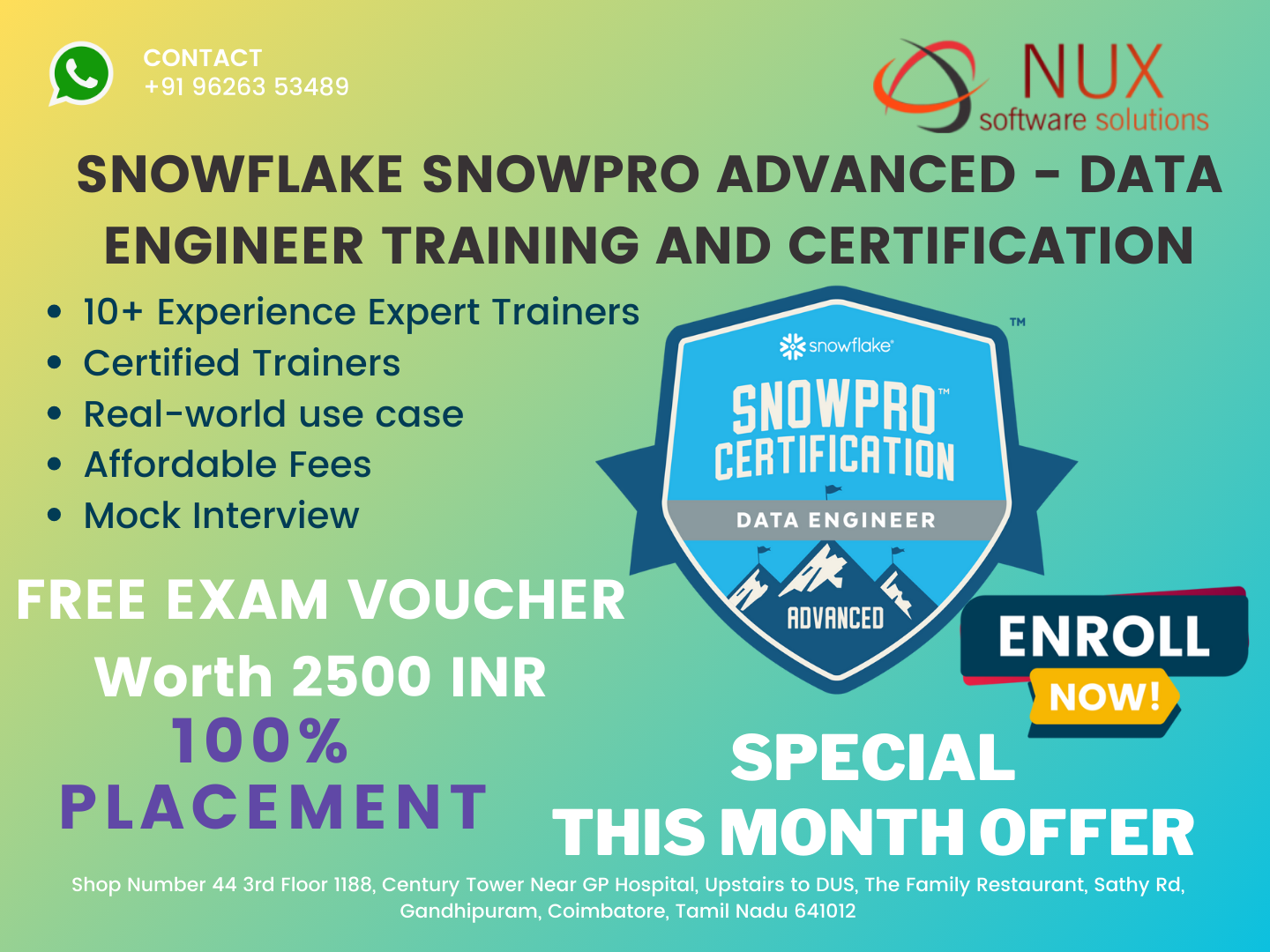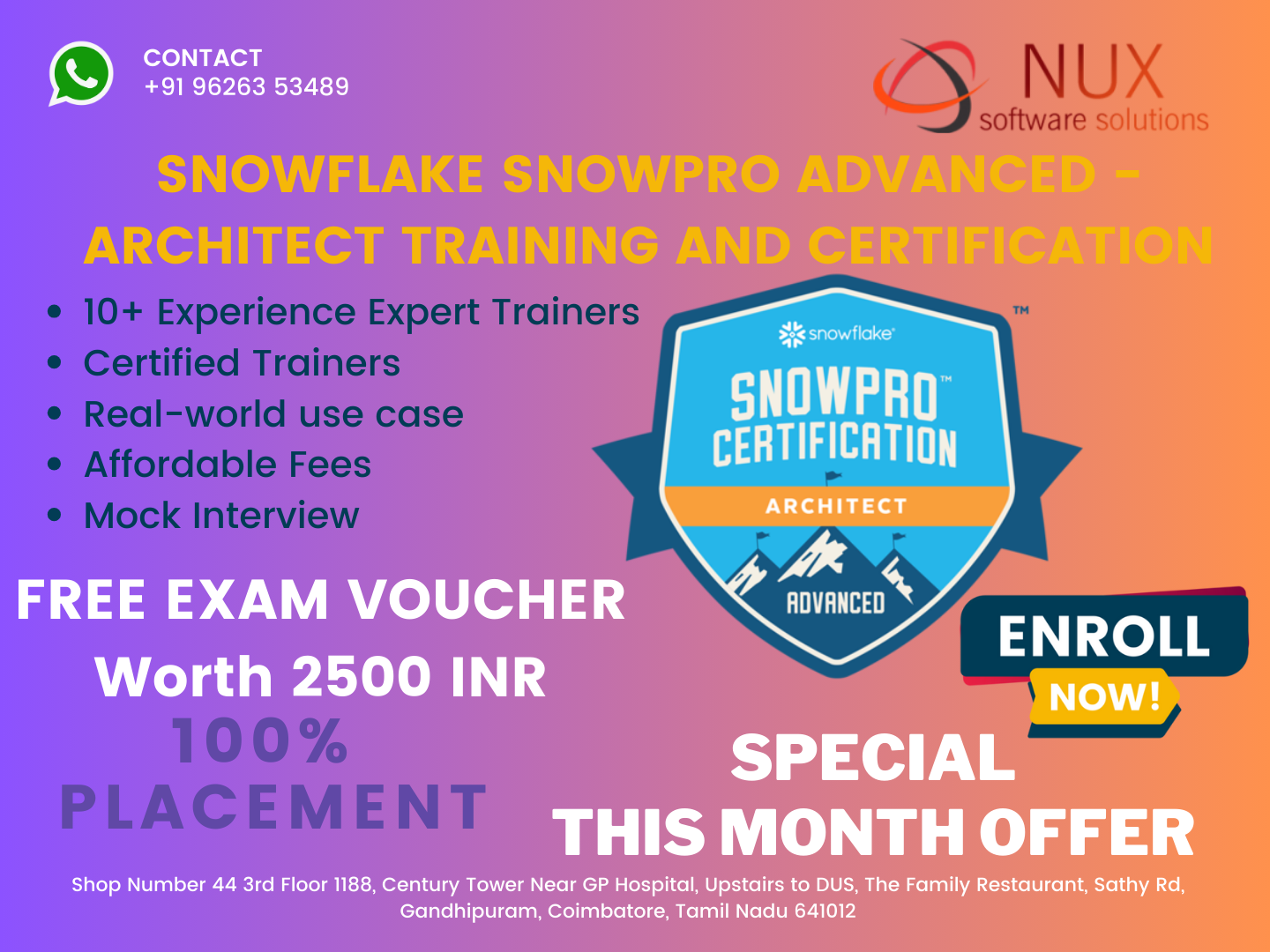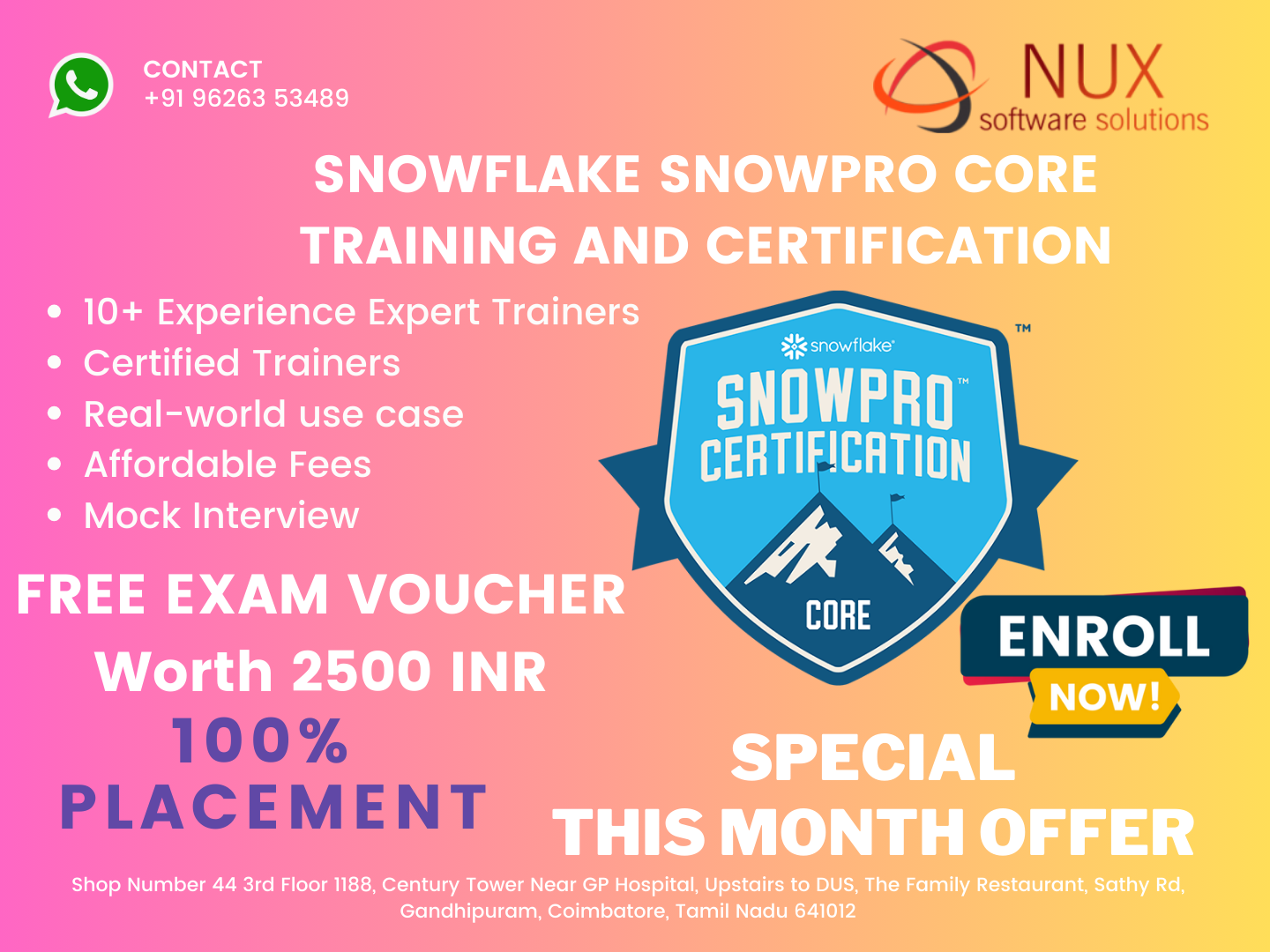Snowflake SnowPro Advanced – Data Engineer


Best Training Institute in coimbatore for Snowflake SnowPro Core Training and Certification.
Nux software Training & Certification Solutions in Coimbatore is the go-to place for comprehensive cloud computing training, particularly in AWS (Amazon Web Services). AWS is a prominent player in the cloud services domain, and gaining expertise in it can indeed open up a plethora of opportunities for businesses and professionals.
Having experienced and knowledgeable instructors is key to mastering AWS, considering its ever-evolving landscape. It’s not just about learning the basics but also understanding how to design applications and systems on AWS, which is crucial in the real-world application of cloud services.
Moreover, the focus on guiding aspirants through the recommended courses, labs, and exams is a structured approach that ensures individuals are well-prepared for AWS certifications. As AWS continues to be a dominant force in the cloud computing industry, having a reliable training institute like Nux software is undoubtedly beneficial for those looking to excel in this field.
Furthermore, we have created a lab with a well-equipped infrastructure and a 24/7 accessible facility that is excellent for experts, corporations, individuals, real project training, and industrial training.
We have placed over 500 registered organizations and 10000+ students and professionals in prestigious roles.
Course Syllabus
Snowflake SnowPro Advanced - Data Engineer
Data Movement - 28%
- Given a data set, load data into Snowflake.
Outline considerations for data loading
Define data loading features and potential impact
- Ingest data of various formats through the mechanics of Snowflake.
Required data formats
Outline Stages
- Troubleshoot data ingestion.
Identify causes of ingestion errors
Determine resolutions for ingestion errors
- Design, build and troubleshoot continuous data pipelines.
Stages
Tasks
Streams
Snowpipe (for example, Auto ingest as compared to Rest API)
- Analyze and differentiate types of data pipelines.
Create User-Defined Functions (UDFs) and stored procedures including Snowpark
Design and use the Snowflake SQL API
- Install, configure, and use connectors to connect to Snowflake.
- Design and build data sharing solutions.
Implement a data share
Create a secure view
Implement row level filtering
- Outline when to use External Tables and define how they work.
Partitioning external tables
Materialized views
Partitioned data unloading
Performance Optimization - 22%
- Troubleshoot underperforming queries.
Identify underperforming queries
Outline telemetry around the operation
Increase efficiency
Identify the root cause
- Given a scenario, configure a solution for the best performance.
Scale out as compared to scale up
Virtual warehouse properties (for example, size, multi-cluster)
Query complexity
Micro-partitions and the impact of clustering
Materialized views
Search optimization service
Query acceleration service
- Outline and use caching features.
- Monitor continuous data pipelines.
Snowpipe
Tasks
Streams
Storage and Data Protection - 10%
- Implement data recovery features in Snowflake.
Time Travel
Fail-safe
- Outline the impact of Streams on Time Travel.
- Use System Functions to analyze Micro-partitions.
Clustering depth
Cluster keys
- Use Time Travel and Cloning to create new development environments.
Clone objects
Validate changes before promoting
Rollback changes
Security - 10%
- Outline Snowflake security principles.
Authentication methods (Single Sign-On (SSO), Key pair Authentication, Username/Password, Multi-factor Authentication (MFA))
Role Based Access Control (RBAC)
Column Level Security and how data masking works with RBAC to secure sensitive data
- Outline the system defined roles and when they should be applied.
The purpose of each of the system defined roles including best practices usage in each case
The primary differences between SECURITYADMIN and USERADMIN roles
The difference between the purpose and usage of the USERADMIN/SECURITYADMIN roles and SYSADMIN
- Manage Data Governance.
Explain the options available to support column level security including Dynamic Data Masking and External Tokenization
Explain the options available to support row level security using Snowflake Row Access Policies
Use DDL required to manage Dynamic Data Masking and Row Access Policies
Use methods and best practices for creating and applying masking policies on data
Use methods and best practices for Object Tagging
Data Transformation
- Define User-Defined Functions (UDFs) and outline how to use them.
Snowpark UDFs (for example, Java, Python, Scala)
Secure UDFs
SQL UDFs
JavaScript UDFs
User-Defined Table Functions (UDTFs)
- Define and create External Functions.
Secure external functions
Integration requirements
- Design, build, and leverage Stored Procedures.
Snowpark stored procedures (for example, Java, Python, Scala)
SQL Scripting stored procedures
JavaScript stored procedures
Transaction management
- Handle and transform semi-structured data.
Traverse and transform semi-structured data to structured data
Transform structured data to semi-structured data
Understand how to work with unstructured data
- Use Snowpark for data transformation.
Understand Snowpark architecture
Query and filter data using the Snowpark library
Perform data transformations using Snowpark (for example, aggregations)
Manipulate Snowpark DataFrames


